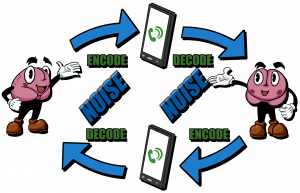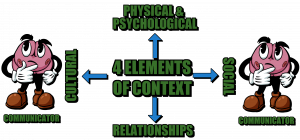1 Principles and Models of Communication
Principles
Chapter 1 Check-in
Communications Models
- Linear
- Interactive
- Transactional
Principles and Models of Communications

Everyone has faced a blank screen or sheet of paper and felt lost. The block is common in every creative process and communication is no different. What makes the block less of a stop is having a plan. Getting from A to B needs navigation, building a bookcase needs a blueprint, wiring a house needs schematics, and cutting hair needs a plan.
Preparation involves different elements and when done well, makes the creation easier. Organizing information based on the needs and expectations of your audience allows you to focus on the writing during the creation stage.
Filling in the details from your organization and outline allows you to focus on the words to establish the connections from point to point. Choose the words based on what you know of your audience: write to meet those needs.
The final touch is to review and revise the final product: check the connections, trim the unnecessary, and find the perfect words. Revision is the mirror check before you step outside.
The Handbook outlines the principles to help you develop an effective style to build effective communication with clients, co-workers, employers, officials, and even family and friends.
We start with a brief understanding of how communication works – a schematic of the process – to provide a framework of what to check when something goes wrong so you can fix it for the next time.
Communication is trust.
Every communication with another person is an example of your integrity: you tell me the truth, and I tell you the truth. You are delivering a message to share an idea or information with another person. To connect with someone else, you demonstrate your reliability. In the Personal Care Trades, that trust is foundational. How you communicate will build that confidence, or the client will move to another service provider.
Your communication style is how you use various elements to express your idea to someone else and receive information from others. Choose your communication techniques carefully to ensure your message is clear and consistent in content and delivery, and context appropriate.
Understanding communication theories makes it easier to design messages to be understood. Models provide visual explanations of concepts to help reinforce a theory by using more than one way to describe the information [The Learning Scientists]. Many people spend years in this academic field of study. We all spend our lives learning how to relate to those with whom we work and live.
What follows is a brief overview of the three basic communication models.
Check the reference information at the end of this section for further reading suggestions.
Questions to guide your reading:
- What is similar and what is different between the models?
- Why are the models divided along these lines?
- What model best describes your daily interactions?
- Are there parts of communication you think are missing from the models?
- How would you draw the interaction?
- What would you remove or add?
Principles: Communication Model
Linear Model
(Terms used: sender, encode, channel, decode, receiver, noise)
This first model covers the basic process: a sender delivers a message to a receiver.

There are three key steps to make this happen. The sender must put the content into a code (encode) and choose a method of transmission (channel) to reach the receiver who in turn will (decode) the message.
Coding and channel can be confusing. The code is what the sender chooses to represent the information and the receiver must be able to understand or decode that system. This is the language. The Channel is about the transmission method. That could be a telephone call, a letter, an Instagram post, a song, a poem, skywriting, or just about anything. Noise is what prevents any part of this system from being successful: it is a barrier to communication.
The linear model is concerned with the one-way flow from the sender to the receiver. The focus is on the sender and the sender’s message. There is little consideration for the content of the message, the delivery, the context of the situation, potential barriers, and even the person or people receiving it.
This is a great example of situations when no response from the receiver is required, expected, or requested. Examples of such linear communication include videos, audio files, articles, books, lectures (school and parental) and it goes on.
Interactive or Interaction Model
(Terms used: sender, encode, channel, decode, receiver, feedback, noise, physical context, psychological context).

This model marks communication as participation: the communicator role is shared between those involved. The sender delivers a message (encoding and choosing a channel, and the receiver decodes) to which a response is requested and even expected. This can take the form of conversations either in person or through texts, phones, emails, seminars, and discussions in a variety of forms. Sender and receiver roles are shared, and feedback is essential for the exchange. The focus is on the feedback loop – a back and forth interchange.
Context of where the communication takes place (physical) and the participants’ personal beliefs, backgrounds, and cultures (psychological) are included as important factors to the experience. These factors can contribute to ‘noise’ or barriers to communication. It is the communicator’s responsibility to analyze the physical and psychological factors and modify the message – content, code, and channel – to reach the other communicator and maintain that feedback loop.
Transaction Model
(Terms used: communicators, co-creating of meaning, four elements of context: physical & psychological; social; relationships; cultural)

This communication model reflects the increase in the number of people you can communicate with at the same time, the impact technology has on channels for communications, and the development of theories and meaning. This is where it gets messy and even more interesting as a field of study.
The communicator bears the responsibility for analysis of the message, audience, situation, and physical and psychological factors that influence the exchange. It is the communicator’s superpower. Unfortunately, it also means that the communicator is responsible for the successful transmission and understanding of the message. If the audience doesn’t understand, it is not their fault. If communication breaks down, it means the communicator didn’t think about the message, the audience, the context, and the delivery enough to make the connection.
How to use the model information
Understanding how the process works provides a tool to figure out why the communication broke down and plan how to avoid that breakdown in the future.
Your communication style is how you deliver information and by how your audience receives your message.
Chapter 1 Check-out:
- Recognize the communication model for any given situation
What communication model is used when you are texting?
Resources
Melissa Alman. (2020). Introduction to Professional Communications. Chapter 3.2 The Communication Process in the Real World. [online].
Chris Drew, Ph.D. (February 23, 2020). All 8 Models of Communication, Explained! [online]. https://helpfulprofessor.com/communication-models/
Megan Sumeracki. (2019). Six Strategies for Effective Learning: A Summary for Teachers. [online]. The Learning Scientists blog. https://www.learningscientists.org/blog/2019/11/28-1
Media Attributions
- Brain Cramp © Luc Grenier
- Linear Model © Luc Grenier
- Interactive Communication Model © Luc Grenier is licensed under a CC0 (Creative Commons Zero) license
- Transactional Communication Model © Luc Grenier is licensed under a CC0 (Creative Commons Zero) license

